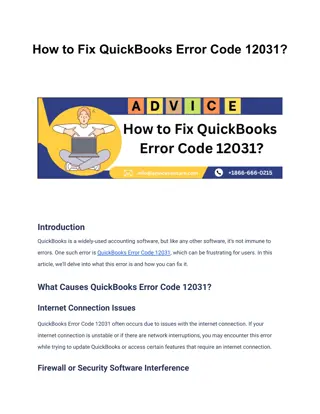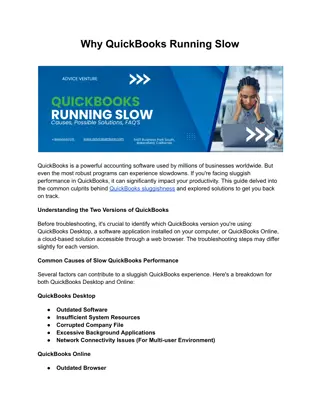
QuickBooks PayPal Integration- Streamlining Your Financial Management
QuickBooks PayPal Integration streamlining your financial management by automating transaction tracking and reconciliation. This integration allows businesses to seamlessly import PayPal transactions into QuickBooks, categorizing income, expenses, and fees accurately. It enhances efficiency by reducing manual data entry, minimizing errors, and providing real-time insights into financial performance. Users can easily reconcile accounts, manage cash flow, and generate comprehensive financial reports. Overall, QuickBooks PayPal integration simplifies the process of managing PayPal transactions.
Download Presentation

Please find below an Image/Link to download the presentation.
The content on the website is provided AS IS for your information and personal use only. It may not be sold, licensed, or shared on other websites without obtaining consent from the author. If you encounter any issues during the download, it is possible that the publisher has removed the file from their server.
You are allowed to download the files provided on this website for personal or commercial use, subject to the condition that they are used lawfully. All files are the property of their respective owners.
The content on the website is provided AS IS for your information and personal use only. It may not be sold, licensed, or shared on other websites without obtaining consent from the author.
E N D
Presentation Transcript
QuickBooks PayPal Integration- Streamlining Your Financial Management QuickBooks PayPal Integration streamlining your financial management by automating transaction tracking and reconciliation. This integration allows businesses to seamlessly import PayPal categorizing income, expenses, and fees accurately. It enhances efficiency by reducing manual data entry, minimizing errors, and providing real-time insights into financial performance. Users can easily reconcile accounts, manage cash flow, and generate comprehensive financial reports. Overall, QuickBooks PayPal integration simplifies the process of managing PayPal transactions alongside other financial activities, providing businesses with a unified platform for effective financial management and decision-making. transactions into QuickBooks, How QuickBooks PayPal Integration Works QuickBooks offers native integration with PayPal, allowing users to connect their PayPal accounts directly to QuickBooks Online or QuickBooks Desktop. This integration enables automatic import of PayPal transactions into QuickBooks, categorizing income, expenses, and fees associated with PayPal transactions accurately.
1. Automatic Transaction Sync: Once transactions on a regular basis. This includes sales receipts, payments received, fees processed through PayPal. Transactions are categorized user-defined categories, ensuring consistency and accuracy in financial reporting. 2. Real-Time Financial Insights: Businesses gain immediate visibility into their PayPal transactions within QuickBooks. This real-time data allows for better cash flow management, monitoring of sales trends, and timely financial decision-making. Integration eliminates the need for manual data entry, reducing errors and freeing up valuable time for financial analysis and strategic planning. 3. Streamlined Reconciliation: Reconciling PayPal transactions with bank accounts becomes more efficient with QuickBooks integration. Users can easily match PayPal transactions imported into QuickBooks with corresponding bank deposits or withdrawals. This streamlines the reconciliation process and ensures that financial records in QuickBooks accurately reflect actual PayPal account activities. 4. Enhanced Reporting Capabilities: Integrated PayPal transactions are seamlessly incorporated into QuickBooks' reporting features. Businesses can generate detailed financial reports, including profit and loss statements, balance sheets, and sales reports that encompass PayPal transactions. Customizable reporting options allow businesses to analyze PayPal sales performance, track transaction fees, and gain insights into customer payment preferences. 5. Multi-Currency Support: QuickBooks supports multi-currency transactions, including those processed through PayPal. Businesses operating internationally can manage and reconcile transactions in various currencies within a single accounting platform. integrated, QuickBooks automatically syncs PayPal deducted by PayPal, and refunds based on predefined rules or
This feature simplifies cross-border financial management and ensures accurate recording and reporting of foreign currency transactions. Benefits of QuickBooks PayPal Integration 1. Efficiency and Time Savings: Automation of transaction syncing eliminates the need for manual data entry, saving time and reducing errors associated with manual processes. Businesses can focus more on core operations and strategic initiatives rather than administrative tasks. 2. Accuracy in Financial Reporting: Integration ensures that PayPal categorized and reflected QuickBooks. Accurate financial data facilitates informed decision-making and compliance with accounting standards and regulatory requirements. 3. Improved Cash Flow Management: Real-time visibility into PayPal transactions helps businesses manage cash flow effectively by monitoring incoming payments, transaction fees, and outgoing expenditures. Predictable cash flow projections planning and budgeting. 4. Enhanced Customer Insights: Detailed transaction records provide valuable insights into customer purchasing behavior, preferences, and payment habits. Businesses can tailor marketing strategies and customer service initiatives based on data-driven insights derived from integrated PayPal transactions. 5. Scalability and Flexibility: QuickBooks PayPal integration scales with business growth, accommodating increased transaction volumes and expanding financial operations seamlessly. Flexible customization options allow businesses to adapt integration settings and reporting parameters to meet specific operational needs and industry requirements. transactions financial are generated by accurately in reports enable proactive financial
Setting Up QuickBooks PayPal Integration QuickBooks Online Integration: 1. Connect PayPal Account: Log in to QuickBooks Online and navigate to the Banking or Transactions tab. Select "Connect account" and choose PayPal from the list of financial institutions. Follow prompts to enter PayPal login credentials and authorize QuickBooks to access PayPal transaction data. 2. Configure Integration Settings: Customize how PayPal transactions are imported and categorized in QuickBooks Online. Define rules for transaction categorization based on income, expenses, fees, and refunds. Set up automatic transaction syncing preferences to ensure timely updates of PayPal transactions in QuickBooks Online. 3. Sync and Review Transactions: Once configured, QuickBooks Online will begin syncing PayPal transactions automatically. Review imported transactions regularly to ensure accuracy and consistency in financial records. Manually adjust categorizations or reconcile discrepancies as needed to maintain data integrity. QuickBooks Desktop Integration: 1. Download and Install Intuit App: Visit the Intuit App Center or QuickBooks Desktop marketplace to download the PayPal app for QuickBooks Desktop. Install the app on your computer and follow on-screen instructions to integrate PayPal with QuickBooks Desktop. 2. Authorize Integration: Launch QuickBooks Desktop and open the PayPal app. Follow prompts to authorize integration by entering PayPal account credentials and granting permissions. Customize integration settings to specify how PayPal transactions should be imported and categorized within QuickBooks Desktop. 3. Sync and Verify Transactions:
After setup, QuickBooks Desktop will sync PayPal transactions according to configured settings. Monitor transaction syncing to ensure accurate recording and reconciliation within QuickBooks Desktop. Adjust settings or reconcile discrepancies as necessary to maintain accurate financial records and reporting. Best Practices for QuickBooks PayPal Integration 1. Regular Monitoring and Reconciliation: Review integrated PayPal transactions regularly to ensure accuracy and completeness. Reconcile PayPal account balances with corresponding QuickBooks promptly. 2. Customize Transaction Categorization: Utilize QuickBooks' customization features to define rules for transaction categorization based on specific business needs and accounting practices. Ensure consistency in categorizing income, expenses, fees, and refunds to facilitate accurate financial reporting. 3. Maintain Data Security: Implement strong security measures to protect sensitive financial data transmitted between QuickBooks and PayPal. Use encryption protocols, secure connections, and access controls to safeguard against unauthorized access or data breaches. 4. Update Integration Settings as Needed: Adjust integration settings in QuickBooks to accommodate changes in business operations, transaction volumes, or financial reporting requirements. Stay informed about updates or enhancements to QuickBooks and PayPal integration features to leverage new functionalities and improvements. 5. Train Users and Maintain Documentation: Provide training to employees QuickBooks and PayPal integration processes. Maintain documentation of procedures, and troubleshooting steps to facilitate continuity and knowledge sharing within the organization. records to identify discrepancies responsible for managing integration settings, transaction
Conclusion QuickBooks streamlining financial management, enhancing efficiency, and gaining actionable insights into financial performance. improving accuracy in financial reporting, and supporting scalability, integration helps businesses optimize cash flow management, improve decision-making, and maintain compliance with accounting standards. Setting up integration requires configuring settings, monitoring transactions regularly, and adhering to best practices for data security synchronization of PayPal transactions into QuickBooks, businesses can achieve greater operational efficiency and focus on growth and innovation in their respective industries. PayPal integration offers businesses a powerful tool for By automating transaction syncing, and customization. With seamless Visit: https://www.adviceventure.com/quickbooks-paypal-integration/






















